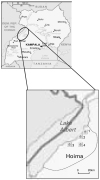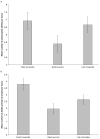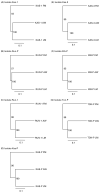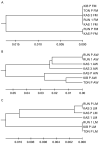Development and application of an ethically and epidemiologically advantageous assay for the multi-locus microsatellite analysis of Schistosoma mansoni
- PMID: 17096873
- PMCID: PMC2613677
- DOI: 10.1017/S0031182006001685
Development and application of an ethically and epidemiologically advantageous assay for the multi-locus microsatellite analysis of Schistosoma mansoni
Abstract
Non-availability of adult worms from living hosts remains a key problem in population genetic studies of schistosomes. Indirect sampling involving passage through laboratory animals presents significant ethical and practical drawbacks, and may result in sampling biases such as bottlenecking processes and/or host-induced selection pressures. The novel techniques reported here for sampling, storage and multi-locus microsatellite analysis of larval Schistosoma mansoni, allowing genotyping of up to 7 microsatellite loci from a single larva, circumvent these problems. The utility of these assays and the potential problems of laboratory passage, were evaluated using 7 S. mansoni population isolates collected from school-children in the Hoima district of Uganda, by comparing the associated field-collected miracidia with adult worms and miracidia obtained from a single generation in laboratory mice. Analyses of laboratory-passaged material erroneously indicated the presence of geographical structuring in the population, emphasizing the dangers of indirect sampling for population genetic studies. Bottlenecking and/or other sampling effects were demonstrated by reduced variability of adult worms compared to their parent field-collected larval samples. Patterns of heterozygote deficiency were apparent in the field-collected samples, which were not evident in laboratory-derived samples, potentially indicative of heterozygote advantage in establishment within laboratory hosts. Genetic distance between life-cycle stages in the majority of isolates revealed that adult worms and laboratory-passaged miracidia clustered together whilst segregating from field miracidia, thereby further highlighting the utility of this assay.
Figures





References
-
- Blair L, Webster JP, Barker GC. Isolation and characterisation of polymorphic microsatellite markers in Schistosoma mansoni from Africa. Molecular Ecology Notes. 2001;1:93–95.
-
- Brouwer KC, Ndhlovu P, Munatsi A, Shiff CJ. Genetic diversity of a population of Schistosoma haematobium derived from schoolchildren in east central Zimbabwe. Journal of Parasitology. 2001;87:762–769. - PubMed
-
- Brouwer KC, Ndhlovu PD, Wagatsuma Y, Munatsi A, Shiff CJ. Urinary tract pathology attributed to Schistosoma haematobium: does parasite genetics play a role? American Journal of Tropical Medicine and Hygiene. 2003;68:456–462. - PubMed
Publication types
MeSH terms
Substances
Grants and funding
LinkOut - more resources
Full Text Sources

